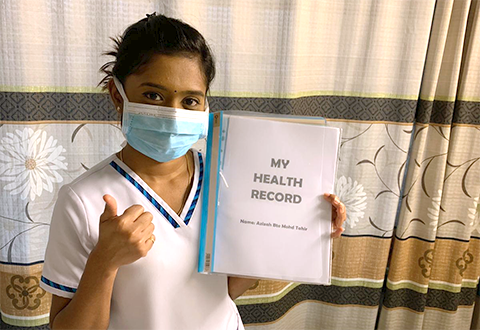
Very often, patients with complex care needs are supported by special medical devices and/ or under multi-drug resistant organism treatment, hence they may not be suitable for rehabilitation. These patients generally require specialised care and would take longer time for recovery before they can be discharged to step-down care at community institutions.
Determined to improve the discharge process of patients with complex care, team PACE started looking into the issues and explored ways to enhance experience of these patients.
BEFORE
Lack of standardisation in teaching resources
Nurses in the wards have been providing bedside teaching to patients and caregivers since the cessation of caregiver training session in SGH back in early 2019. “There was a lack of visual aids and the use of medical jargons in the previous caregiver training booklet made it challenging for patients/ caregivers to understand,” shared Senior Nurse Manager Jasmine Lee, Ward 44 who facilitated the team’s project.
The nurses then took their initiative to augment the teachings with their own materials. This resulted in inconsistency in the information given to patients and their caregivers, and caused confusion.

Patients and caregivers expressed that the caregiver training booklet was difficult to understand.
Unfamiliarity with obtaining discharge information
During the processing of discharge, multiple parties including doctors, physiotherapist, dietitian and other ancillary staff would require to provide the necessary information and instructions required for the patients. However, as there was no standard guidelines or resources, nurses would either write down instructions for the patients or print out the information required from different sources.
In addition, nurses have to also arrange for transportation, follow-up appointments, medications, equipment and consumables delivery for patients which take up considerable time, contributing to the prolonged discharge process.
AFTER
An improved discharge planning workflow
Team PACE reviewed and redesigned the discharge planning workflow. The improved workflow now comprises discharge planning on admission, in-house teaching slides for patients and caregivers, and interventions to facilitate a new discharge checklist.

Newly developed caregiver training checklist and structured guidelines aid nurses in the discharge planning process.
“Complex cases are referred to Patient Navigators early to assist in discharge planning. The Patient Navigator will review patients within 24 hours and assess the discharge plan when there is a change in patient’s condition. This gives caregivers adequate time to prepare for discharge of patient to home,” shared team leader Nurse Clinician (NC) Siti Fidawati Binte Jasman, Ward 44. The PN works closely with the staff nurse to go through a newly developed caregiver training checklist and the structured guidelines for caregivers to follow-up at home.
“We recognise that teaching materials need to be easy to understand in order for patients and caregivers to feel confident in caring for patients with complex care needs. Hence we customised our teaching slides accordingly for different aspects of nursing care to cater to the needs of the patients,” said NC Aishabi Sidik, Ward 56 who also assumes the role of PN in the ward.

Each patient receives their own discharge folder with teaching handouts, discharge summary and key contact numbers in case of emergencies.
“Patients and their caregivers can now access all the information they need, conveniently from one discharge folder that is neat and easy to refer to,” said team member, Senior Staff Nurse Hari Devi Shanmugum, Ward 44B.
Similarly, arrangements for transportation, appointments, medications, delivery of equipment and consumables are also performed a day before discharge to ensure a smoother and faster discharge.
“On the actual day, nurses just have to take note of new medications added and prepare the discharge instructions according to the checklist,” said NC Siti.
Outcomes of the project
80% of the caregivers responded that the multi-faceted approach has raised their confidence in caring for the patients at home, which was a huge improvement from the earlier 30% who felt otherwise. The improved workflow showed a reduction of time to discharge a patient with complex care needs, from 66% of nurses needing over an hour previously, to 95% being able to complete the discharge process within an hour.
With the significant results and success, the improved workflow has been extended to Ward 56 and Cardiothoracic Intensive Care Unit, and they have adopted the discharge slides and folder for their use.

Team PACE (front row) with project facilitators (back row) Lay Sock Yee and Jacqueline Huo from Operations (Management Information & Performance Management). Team PACE members from left to right: NC Aishabi Sidik, Ward 56; NC Siti Fidawati Binte Jasman, Ward 44; and NC Belinda Wong, Ward 44. Not pictured are SNM Jasmine Lee, Ward 44; SSN Hari Devi Shanmugum and Acting NC Charmaine Ong, Ward 44B; Kwek Swee Sin, Cardiac Physiotherapy Services; and Dr Chakarmakkil Mathew Jose, Department of Cardiothoracic Surgery.













 Get it on Google Play
Get it on Google Play